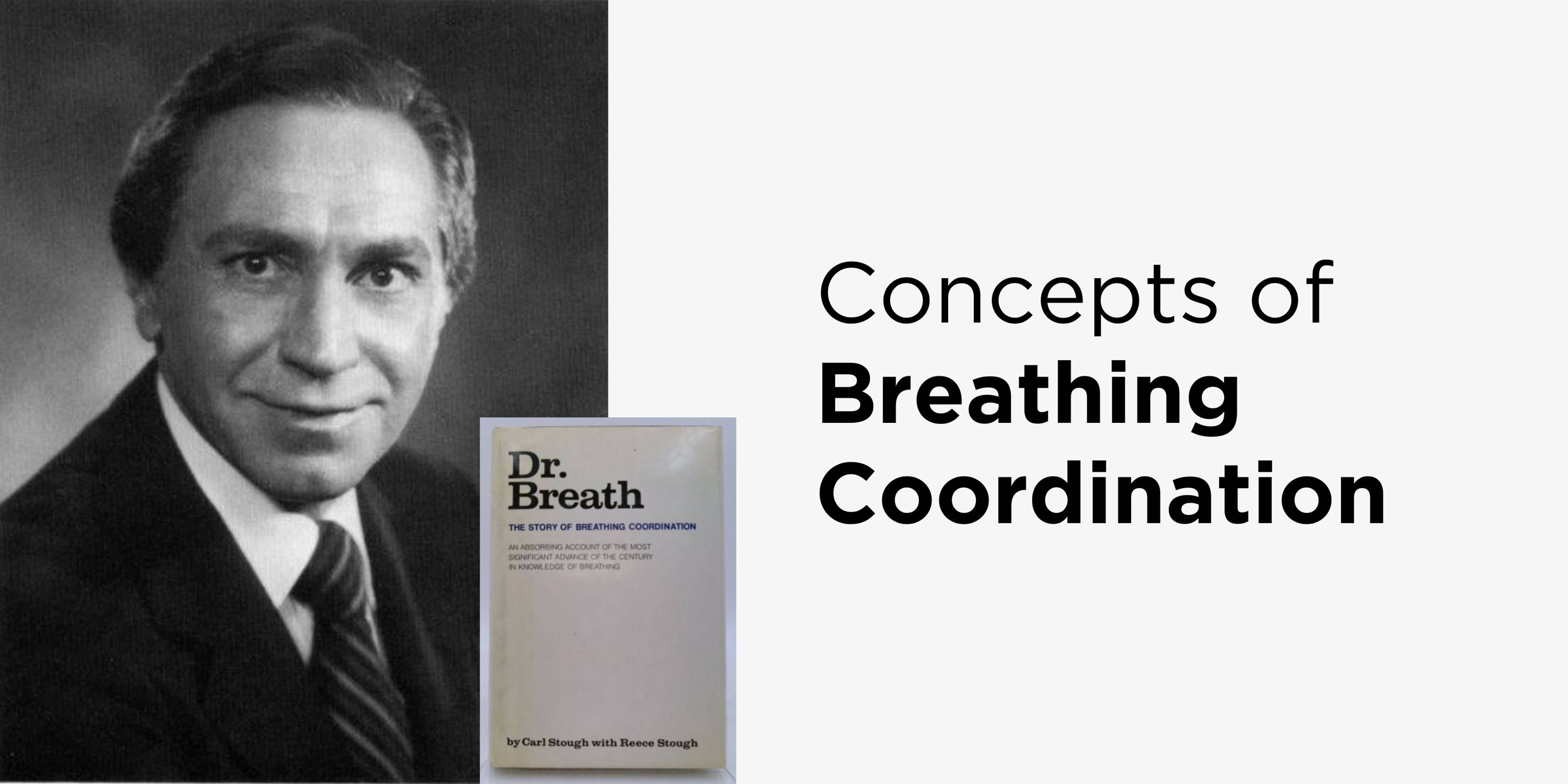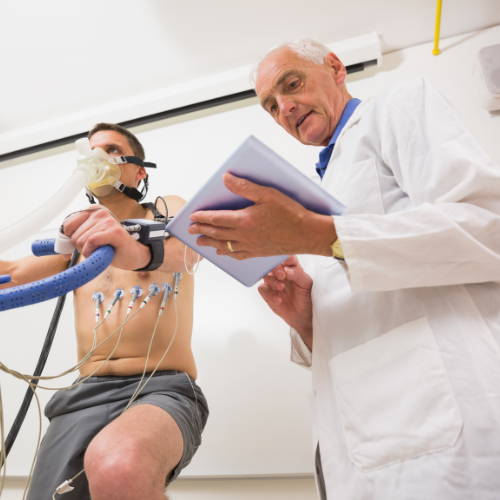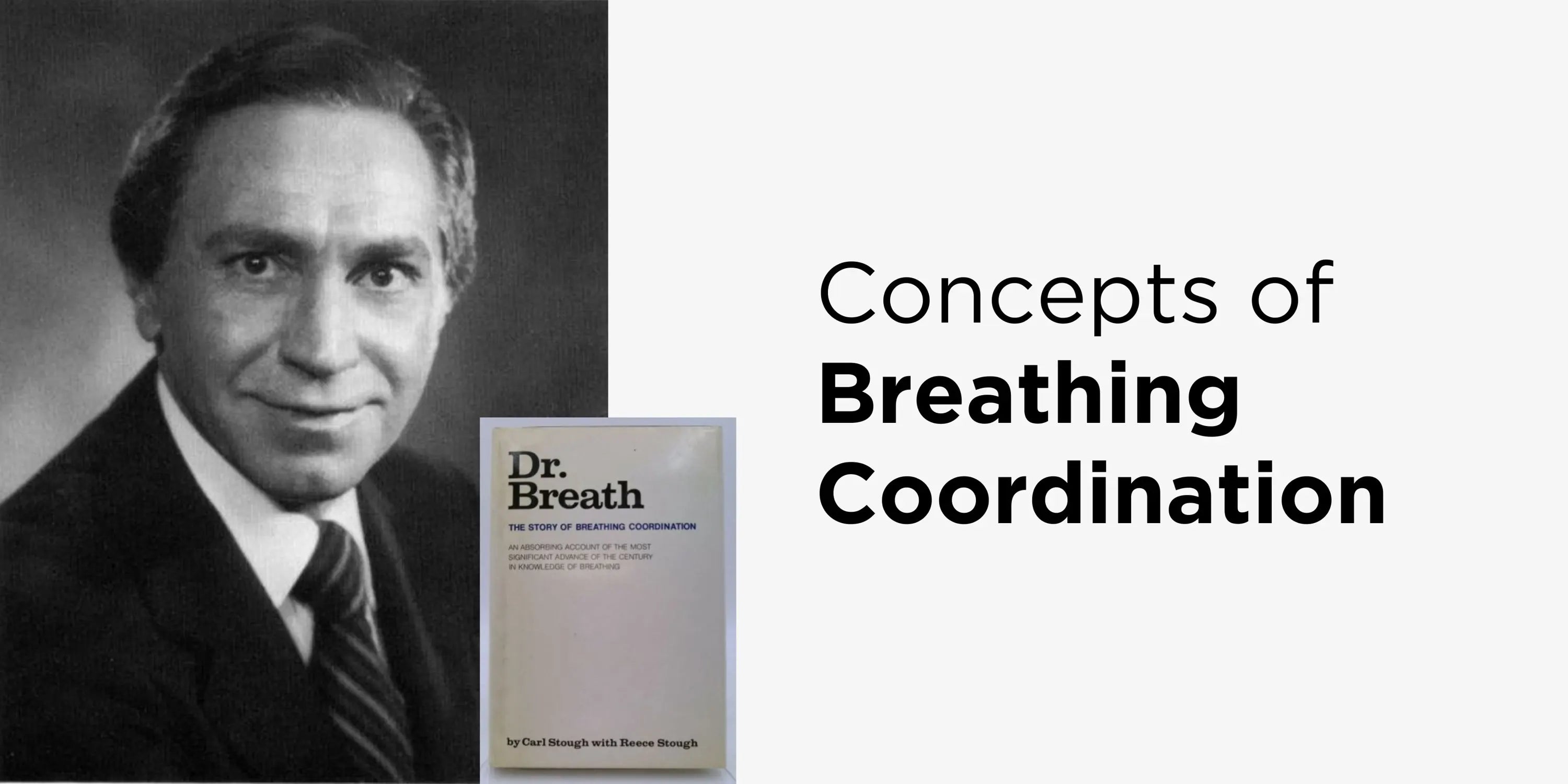Concepts de Carl Stough sur la coordination respiratoire, les défauts respiratoires et les muscles respiratoires accessoires
Les concepts de coordination respiratoire, de défauts respiratoires et de muscles respiratoires accessoires
30 MARS 2023
Le blog discute de l’importance de la coordination et de l’équilibre respiratoire pour une santé et des performances optimales. Il couvre diverses méthodes, techniques et exercices de respiration pour améliorer les schémas respiratoires, la capacité pulmonaire et le bien-être général.

Carl Stough m'a ouvert les yeux sur le concept de coordination respiratoire.
Le regarder travailler sur les gens m'a donné des connaissances approfondies sur ce que j'ai appris à appeler le réflexe respiratoire naturel ou la pierre de Rosette de la respiration. Le réflexe respiratoire doit être ressenti, comme il faut goûter le chocolat.
Il devrait y avoir une ondulation naturelle et dégagée des genoux jusqu'au sommet de la mâchoire. Cette action doit être soutenue/permise par une colonne vertébrale flexible. Les techniques de mouvement fonctionnent bien avec la coordination globale du corps, de l'équilibre et de l'efficacité de la mise en charge. Cependant, la respiration est rarement abordée comme un élément distinct et unique.
Les muscles respiratoires accessoires voisins gênent souvent l’action respiratoire alors qu’ils devraient apporter un soutien mais restent quelque peu isolés. Nous utilisons des informations clés sur la coordination respiratoire, le séquençage de l’équilibre et l’intégration dans notre travail.
Certains exemples faciles à observer présentent des défauts respiratoires légers à graves, tels que des côtes déformées évasées ou enfoncées, des épines trop courbées et des poitrines légèrement ou sévèrement effondrées. Le bas de mon sternum allait sensiblement vers l'intérieur et ressemblait à un divot ou à une sorte de « nid-de-poule » au milieu de la poitrine, alias pectus excavatum.
Les côtes qui rentrent quand on inspire ou qui sortent quand on expire sont aussi des défauts respiratoires. Aussi, des diaphragmes qui se dilatent et se contractent simultanément d’avant en arrière (paradoxal). Les victimes de la polio constituent un groupe qui pourrait en avoir un ou plusieurs, mais n'importe qui peut les avoir développées ou naître avec.
La plupart des personnes que j’ai rencontrées souffrent d’une suractivation des muscles respiratoires accessoires. Muscles respiratoires qui soutiennent les muscles respiratoires principaux mais réagissent de manière excessive et gênent. Imaginez 2 à 5 personnes essayant de vous aider à signer votre nom et combien il serait difficile de les coordonner toutes en même temps. Chaque personne a une idée légèrement ou très différente de ce à quoi devrait ressembler votre signature.
Cette activation accessoire des muscles respiratoires est rendue plus évidente lorsque la personne prend une profonde inspiration et que la clavicule et/ou les épaules se soulèvent et/ou les muscles du cou se gonflent. Des exemples plus extrêmes sont l'emphysème, où parfois presque tout le corps se raidit pour avoir le souffle coupé.
Une façon de détecter cette forme d’ UDB consiste à utiliser le son de la voix. La voix, après tout, n’est rien d’autre que des membranes, des os, des tendons et des muscles qui traversent le vent et qui créent différentes qualités de vibration et de son. La voix devient haletante, rauque, fine, rauque, faible ou instable. Un signe certain de besoins de développement de la coordination respiratoire.
Essayez d'émettre un son régulier, uniforme et inébranlable avec votre voix, et en même temps, faites entrer et sortir votre ventre une fois par seconde comme si vous faisiez la transition entre une grossesse de six mois et une culturiste physique à taille fine avec une petite taille et énorme poitrine. La plupart ressentiront une hésitation du son. Un facteur clé de l’oscillation est causé par le fait que les muscles du ventre gênent l’action du diaphragme.
Pour respirer, chanter, parler, marcher, dormir et chanter plus facilement , il faut se désengager des muscles du ventre. Nous devons également coordonner l'action afin que l'ensemble de l'unité soit correctement soutenu et que les relations entre le diaphragme, le ventre, la poitrine, la bouche, la gorge et la mâchoire soient maintenues dans une intégration stable mais détendue. Certaines pressions de la position allongée favorisent ou suppriment clairement la facilité de respiration.
Les femmes connaissent souvent de nombreux problèmes post-partum ; certains sont plus graves que d'autres. Chacun des problèmes présente des symptômes distincts et certains ont deux ou plusieurs traits en commun.

Apprendre
Respiration optimale
Comprenez et développez les avantages d'une respiration correcte et comment elle peut vous aider dans toutes les facettes de la vie.
Dormir
Lorsque la voie respiratoire naturelle est restaurée ou améliorée, il y a presque toujours une profondeur et/ou une facilité correspondantes dans l'état de sommeil. Plus la respiration est profonde, plus le sommeil est profond . C’est probablement la raison pour laquelle ronflement et profondeur du sommeil sont souvent associés. La respiration est plus profonde mais pas aussi coordonnée qu’elle le pourrait, ou d’autres problèmes sont mentionnés concernant le sommeil.
Le bégaiement, la laryngite, l'emphysème, la dysphonie spasmodique, les maladies cardiaques, les troubles nerveux, l'hypertension et bien d'autres maladies peuvent être influencés positivement ou négativement par la façon dont on respire.
Ces schémas et séquences donnent un aperçu de l’apparence, de la sensation et du fonctionnement de la respiration. Il existe différentes manières de les aborder, enseignées dans notre école et dans nos programmes d'études à domicile. Ils comprennent la fonction du diaphragme, l’expansion des côtes et des poumons et les interrelations musculaires et sont régis à bien des égards par la posture et l’attitude. Ils impliquent une bonne intégration entre les parties du bassin, du ventre, du dos, des côtés, de la poitrine, de la gorge et de la mâchoire du cycle respiratoire, couplée à une perception intérieure de facilité, de flux, d'unité/intégralité et de fondement. La qualité de la production sonore vocale est essentielle à une évaluation appropriée.
Il devrait y avoir une ondulation naturelle et dégagée depuis la plante des pieds et le ventre jusqu'au sommet de la mâchoire et de la tête. Cette action doit être soutenue par les pieds, les jambes et les hanches ; la fondation du corps, ou le support inférieur. L'atrophie - perte du contrôle respiratoire - survient à la suite d'un traumatisme ou d'années de non-utilisation ou d'utilisation inappropriée. Fonction sensorimotrice - la fonction cerveau-corps enseignée par des personnes comme Thomas Hanna, créateur de Somatics, Stanley Keleman et Thomas Myers est compromise, et la conscience somatique interne d'une respiration saine se perd avec un déséquilibre concomitant du système nerveux.
Ensuite, une réponse réflexe répétée du tronc cérébral provoque une contraction permanente invitant ou exacerbant des postures inappropriées et une détérioration du diaphragme, entraînant des troubles du rythme respiratoire. Si quelqu’un vous demande de respirer correctement et vous montre comment, vous ne pouvez souvent pas le faire car vous avez perdu la perception intérieure nécessaire à cela. Une meilleure respiration doit souvent être doucement mise en place par un facilitateur expert.
Une série d'événements et/ou d'exercices respiratoires ou physiques qui utilisent un affect répété et unique entraîneront le plus souvent une limitation de la respiration, laissant la place à de futures inhibitions ou distorsions respiratoires.
La respiration est rarement abordée comme une composante distincte et unique. « Au centre de la scène » pour ainsi dire. Les radiographies ne montrent pas les muscles et n’enregistrent pas le son. Le travail corporel peut être d’une grande aide, mais ne peut pas aller assez en profondeur pour modifier les muscles très profonds et le dessous des muscles respiratoires accessoires. Les techniques de mouvement fonctionnent bien avec la coordination globale du corps en termes d'équilibre et d'efficacité de mise en charge, mais l'intolérance énergétique et/ou les muscles et les os « accessoires » voisins gênent l'action respiratoire alors qu'ils devraient être plus isolés.
De nombreuses personnes souffrent ou développeront des troubles respiratoires légers à graves, tels que des côtes évasées ou enfoncées, une colonne vertébrale trop courbée ou une poitrine légèrement ou gravement effondrée. Le bas de mon sternum allait sensiblement vers l'intérieur (après avoir été frappé au ventre et intimidé, ce qui m'a obligé à me pencher en avant pendant ma jeunesse et mes années de croissance) et ressemblait à un divot ou une sorte de « nid-de-poule » thoracique.
Les côtes qui rentrent quand on inspire ou qui sortent quand on expire doivent être considérées comme des défauts respiratoires. Les diaphragmes qui se dilatent d’un côté et se contractent simultanément de l’autre (paradoxal) servent également à déséquilibrer la respiration.
La plupart des gens que j’ai rencontrés ont des muscles respiratoires accessoires hyperactifs. Les muscles respiratoires accessoires sont des muscles qui s’activent lors d’une tentative de respiration plus profonde ou même superficielle. Les athlètes en ressentent beaucoup en haletant ou en haletant. D’autres par habitude, émotions coincées ou traumatisme. Un bon exemple est de lever les épaules lorsque l’on prend une profonde inspiration.
Des exemples extrêmes sont l'emphysème, où parfois presque tout le corps devient une série de muscles respiratoires accessoires sans isolation ni séparation de l'action musculaire.
Essaye ça.
Renforcez TOUS les muscles de votre corps, de la tête aux pieds. Maintenant, essayez de prendre une profonde inspiration et vous verrez un peu ce que c'est que d'essayer de respirer avec l'emphysème. Malheureusement, nous nous dirigeons TOUS dans cette direction si nous ne faisons pas consciemment quelque chose pour l’empêcher. Si vous ne l'utilisez pas, vous le perdrez.
Un moyen simple de détecter la présence bien cachée des facteurs UDB par le nombre de tests respiratoires optimaux et le son de la voix. La voix est essentiellement provoquée par le vent, les frottements et les vibrations ; le vent traverse les membranes, rebondit et/ou fait vibrer les muscles, les tendons, les nerfs et les os. Tout comme un immeuble de bureaux s’inclinerait ou se plierait sans un sous-sol suffisamment grand, la voix a besoin d’une fondation adéquate pour soutenir son uniformité et sa force. De plus, une plate-forme à partir de laquelle jaillir lorsque le son doit être fort et clair.
Ces différentes qualités de vibration et de son produisent des vibrations fortes, régulières, pleines, rauques, fines, rauques, faibles, instables en grande partie à cause d'une mauvaise posture déformant la forme des membranes et/ou d'une mauvaise fondation.
Essayez d'émettre un son régulier, uniforme et inébranlable avec votre voix et en même temps, faites entrer et sortir votre ventre une fois par seconde, comme si vous faisiez la transition entre une grossesse de six mois et une culturiste physique maigre et émaciée avec une petite taille et une poitrine énorme. La plupart ressentiront une hésitation du son. Un facteur clé de l’oscillation est causé par le fait que les muscles du ventre gênent l’action du diaphragme. Pour respirer, parler, marcher, dormir et chanter plus facilement, nous devons être capables d'engager et de désengager le ventre et d'autres muscles respiratoires non spécifiques. Nous devons également coordonner l'action afin que l'ensemble de l'unité soit correctement soutenu et que les relations entre le diaphragme, le ventre, la poitrine, la bouche, la gorge et la mâchoire soient maintenues dans une intégration stable mais détendue. Nous développons tout cela dans le cadre de programmes d'auto-assistance ou de séances privées .
Et lorsque la voie respiratoire naturelle est restaurée ou améliorée, il y a presque toujours une profondeur et/ou une facilité correspondantes dans l'état de sommeil. Plus la respiration est profonde, plus le sommeil est profond. C’est probablement la raison pour laquelle ronflement et profondeur du sommeil sont souvent associés. La respiration est plus profonde mais pas aussi forte intérieurement qu’elle le devrait ou il y a d’autres problèmes concernant le sommeil.
Le bégaiement, la laryngite, l'emphysème, la dysphonie spasmodique, les maladies cardiaques, les troubles nerveux, l'hypertension et bien d'autres maladies peuvent être influencés positivement ou négativement par la façon dont on respire. Encore une fois, si vous ne faites pas consciemment quelque chose pour éviter la perte de volume respiratoire, de force et de séquence respiratoire, alors même les activités habituelles et habituelles entraîneront une perte de la fonction respiratoire et de la vitalité correspondante. Si vous ne l'utilisez pas, vous le perdrez. Un stress excessif ne fait qu’accélérer la perte.
Un exemple tiré de séances avec des clients atteints de dysphonie spasmodique :
C'est plutôt ce à quoi je veux en venir avec votre SD : il s'agit en grande partie d'un problème de séquencement et de coordination du diaphragme et de la respiration qui est causé par le système respiratoire des hanches, du bassin, de l'abdomen, du thorax, du diaphragme, des organes internes, des fascias, de la gorge et de la mâchoire. être écrasé, plié, trop tendu et tordu de manière subtile qui défie toute mesure mais répond à des positions inhabituelles du corps qui ramènent la coordination interne là où elle fonctionne mieux... immédiatement. Des changements subtils dans la voix en sont les principaux indicateurs. Au début, ils peuvent ne pas être perceptibles par le créateur du son qui a perdu son lien avec le son de sa voix naturelle. Mais un enregistrement sur bande avant et après peut l'aider à entendre les changements vocaux s'il ne peut pas le faire lui-même.
Nous devons bien sûr avoir déjà ouvert (via les Optimal Breath Releases -OBRs- et les techniques de cerclage, etc.) l'ensemble du système pour apporter le maximum de changement possible et assurer le succès. Nous prenons ensuite des positions corporelles étranges, parfois menaçantes, invasives, de mauvais goût (la pose de la prima donna, des distorsions corporelles grotesques ou étrangères et éventuellement menaçantes, etc.) et permettons à la coordination respiratoire de trouver sa propre voie en émettant des sons en même temps que ces corps "différents". postes. Cela arrive assez souvent et le corps se reforme intérieurement (se détend), permettant à la nouvelle façon de sonoriser de devenir spontanée tandis que la position corporelle ODD devient de moins en moins nécessaire et nous revenons lentement à une posture saine.
Ainsi, la coordination interne est modifiée en émettant du son tout en étirant et en pliant l'extérieur du corps qui est après tout le conteneur de l'intérieur en premier lieu. Encore une fois, cela se déroule de l’intérieur vers l’extérieur. Les positions précises du corps sont essentielles.
La relation à soi est basée sur la relation à ses sentiments et à ses émotions. Mais il est préférable d’avoir nos émotions et non que nos émotions nous possèdent. Peu de gens savent comment s’y prendre car la respiration est un facteur clé. Certains professeurs de chant peuvent être très doués dans ce domaine, d’autres non. Je me suis engagé sur le chemin de la croissance personnelle et j'ai donc passé trois ans à suivre des cours de chant qui ne m'ont pas appris à chanter. Trois heures à trois semaines devraient suffire pour beaucoup. Ne vous perdez pas dans les erreurs bien intentionnées mais souvent déroutantes de personnes vous disant de faire des choses qui ne vous semblent pas bien ou qui n'obtiennent pas de résultats immédiats.

Rencontrez Mike White
Rencontrez Michael Grant White, le coach de respiration optimale et obtenez des informations concrètes sur votre développement respiratoire, votre santé et votre longévité.

Quelle est votre respiration ?
Vous voulez connaître l’avenir de votre santé et de votre longévité ?
Articles les plus populaires

12 avril 2021


10 février 2022


Atteignez des niveaux d’exercice satisfaisants sans aggraver le cœur existant.
Comprenez et explorez EWOT - Exercice avec oxygénothérapie.
Entretiens avec Denis
Articles sur la respiration et l'oxygène
-
Respiration
-
Oxygène
- La moisissure pourrait être présente dans votre maison en ce moment. Êtes-vous à risque ?
- Combattre le stress au travail de la bonne manière
- La mauvaise respiration provoque l’asthme – Voici quoi faire !
- Respiration optimale, autisme et développement cérébral
- Pourquoi mieux respirer ? La mauvaise respiration vous rend malade ou encore plus malade. Apprenez à mieux respirer maintenant
- Guérissez vos problèmes respiratoires avec des exercices de respiration
Rencontrez et travaillez avec nos praticiens
Obtenez une aide personnelle pour améliorer votre santé
et de la vitalité.
Bénéficiez d’un coaching et de conseils d’experts de la part de nos experts en respiration optimale.
Que vous recherchiez un expert en Respiration Intégrale, Voice Coach
ou quelqu'un qui se spécialise dans l'anxiété ou la dépression, ne cherchez pas plus loin.
Présentation du système Turbo Oxygen
EWOT SUR LES STÉROÏDES Basé sur la thérapie à l'oxygène en plusieurs étapes, également appelée OMT
Accélération du bien-être, de l’endurance physique, de la clarté mentale et bien plus encore. Aujourd’hui, les gens sont plus soucieux de leur santé que jamais. Les hommes et les femmes ont toujours utilisé la salle de sport comme lieu social ainsi que comme lieu de remise en forme, mais beaucoup de ces personnes qui appartenaient à des salles de sport trouvent désormais plus facile et plus pratique et, dernièrement, même en économisant de l'essence, de s'entraîner à la maison avec des produits achetés en magasin. équipement.
Vous connaissez la sensation que vous ressentez lorsque vous vous réveillez tôt pour vous entraîner ?




